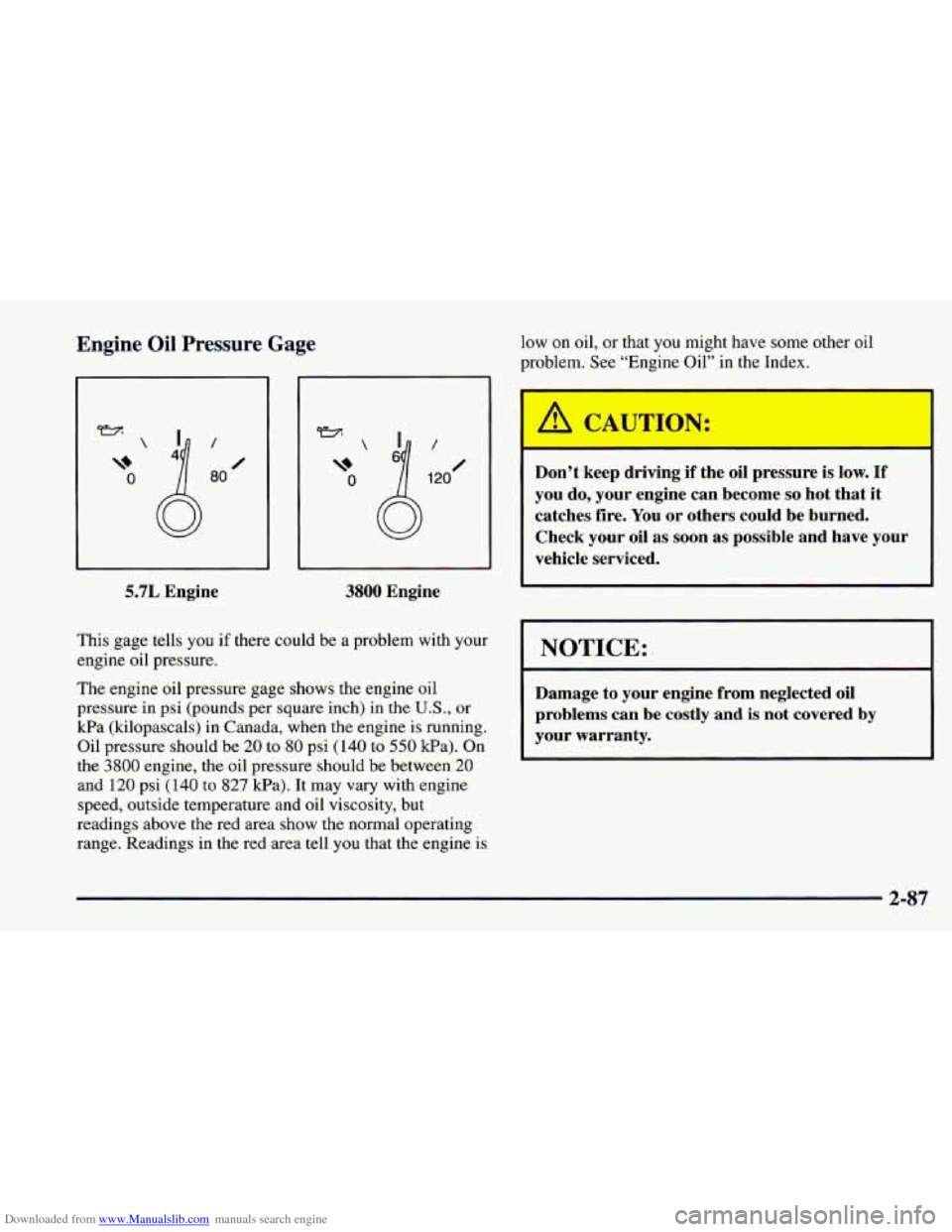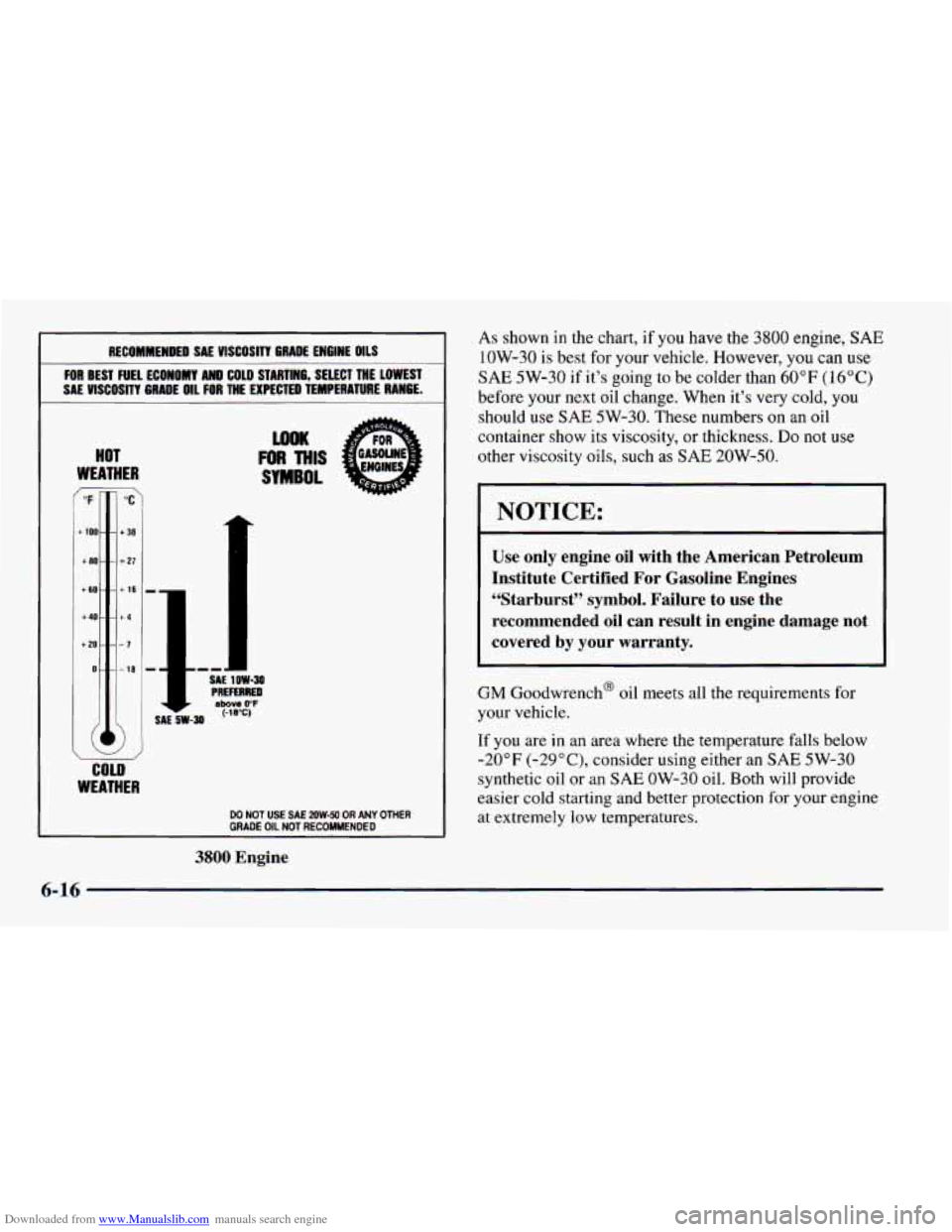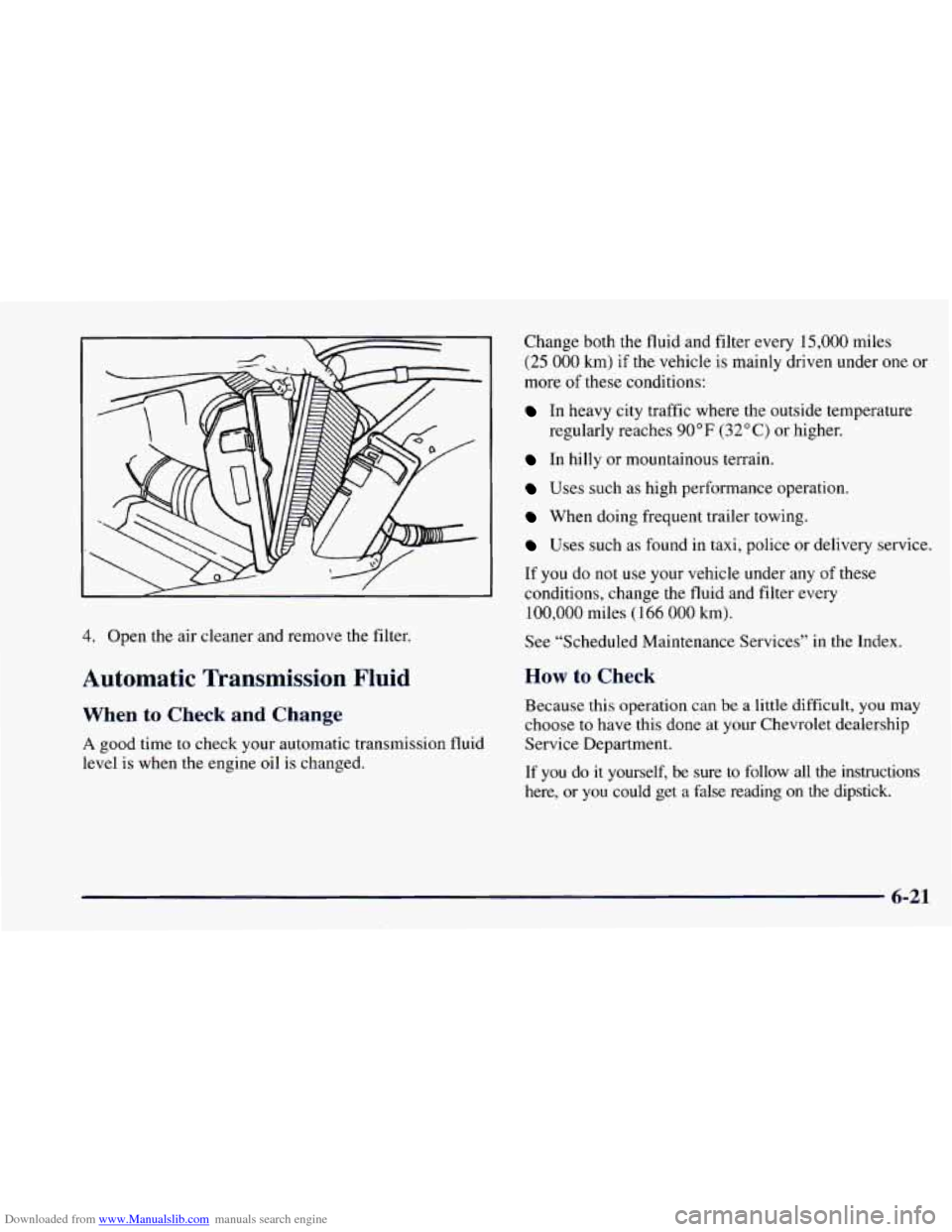1997 CHEVROLET CAMARO oil temperature
[x] Cancel search: oil temperaturePage 78 of 404

Downloaded from www.Manualslib.com manuals search engine To Use the Coolant Heater
1. Turn off the engine.
2. Open the hood and unwrap the electrical cord.
3. Plug it into a normal, grounded 1 10-volt AC outlet.
Plugging the cord into an ungrounded outlet
could cause an electrical shock.
Also, the wrong
kind
of extension cord could overheat and cause
a fire. You could be seriously injured. Plug the
cord
into a properly grounded three-prong
110-volt
AC outlet. If the cord won’t reach, use a
heavy-duty three-prong extension cord rated for
at least
15 amps.
4. Before starting the engine, be sure to unplug and
store the cord as
it was before to keep it away from
hot pipes, manifold or moving engine parts. If you
don’t,
it could be damaged.
How long should
you keep the coolant heater plugged
in? The answer depends
on the outside temperature, the
kind
of oil you have, and some other things. Instead of
trying to list everything here, we ask that you contact
your Chevrolet dealer in the area where you’ll be
parking your vehicle. The dealer can give you the best
advice for that particular area.
2-28
Page 137 of 404

Downloaded from www.Manualslib.com manuals search engine Engine Oil Pressure Gage low on oil, or that you might have some other oil
problem. See “Engine Oil” in the Index.
\+
0
/
0 80
ez
\+
0
/
120 0
5.7L Engine 3800 Engine
This gage tells you if there could be a problem with your
engine oil pressure.
The engine oil pressure gage shows the engine oil
pressure
in psi (pounds per square inch) in the U.S., or
kPa (kilopascals) in Canada, when the engine is running.
Oil pressure should be
20 to 80 psi (140 to 550 kPa). On
the
3800 engine, the oil pressure should be between 20
and 120 psi (140 to 827 kPa). It may vary with engine
speed, outside temperature and oil viscosity, but
readings above the red area show the normal operating
range. Readings in the red area
tell you that the engine is
Don’t keep driving if the oil pressure is low. If
you do, your engine can become so hot that it
catches fire. You or others could be burned.
Check your oil as soon
as possible and have your
vehicle serviced.
I NOTICE: I
Damage to your engine from neglected oil
problems can be costly and
is not covered by
your warranty.
Page 261 of 404

Downloaded from www.Manualslib.com manuals search engine RECOMMENDED SAE VISCOSITY GRADE ENGINE OILS
FOR BEST FUEL ECONOMY AND COLD STARTING, SELECT THE LOWEST
SAE
VISCOSITY GRADE 011 FOR THE EXPECTED TEMPERATURE RANGE.
HOT
WEATHER
WOK
FOR THIS
SYMBOL
"F
+ 100-
+ 80 -
+ 60 -
+40-
+ 20 -
0-
\I
SAE SW-M PREFERRED
I SAE I law-30
COLD
WEATHER
DO NOT USE SAE 2OW-50 OR ANY OTHER
GRADE OIL NOT RECOMMENDED
5.7L Engine
As shown in the chart, if you have the 5.7L engine,
SAE 5W-30 is best for your vehicle. However, you can
use SAE 1OW-30 if it's going to be 0°F (-18°C) or
above. These numbers on an oil container show its
viscosity, or thickness.
Do not use other viscosity oils,
such as
SAE 20W-50.
6-15
Page 262 of 404

Downloaded from www.Manualslib.com manuals search engine RECOMMENDED SAE VlSCOSlTT GRADE ENGINE OILS
FOR BEST FUEL ECONOMY AND COLD STARTING, SELECT THE LOWEST
SAE VISCOSITY GRADE
OIL FOR THE EXPECTED TEMPERATURE RANGE.
HOT
WEATHER
WOK
FOR MIS
SYMBOL
wi
COLD
WEATHER
DO NOT USE SA€ 2OW-50 OR ANY OTHER GRADE OIL NOT RECOMMENDED
3800 Engine
As shown in the chart, if you have the 3800 engine, SAE
1OW-30 is best for your vehicle. However, you can use
SAE 5W-30 if it’s going to be colder than 60°F (16°C)
before your next oil change. When it’s very cold, you
should use
SAE 5W-30. These numbers on an oil
container show its viscosity,
or thickness. Do not use
other viscosity oils, such as SAE 20W-50.
NOTICE:
Use only engine oil with the American Petroleum
Institute Certified For Gasoline Engines “Starburst” symbol. Failure to use the
recommended oil can result in engine damage not
covered by your warranty.
GM Goodwrench@ oil meets all the requirements for
your vehicle.
If you are in an area where the temperature falls below
-20°F (-29”C), consider using either an SAE 5W-30
synthetic oil or an
SAE OW-30 oil. Both will provide
easier cold starting and better protection for your engine
at extremely low temperatures.
6-16
Page 263 of 404

Downloaded from www.Manualslib.com manuals search engine Engine Oil Additives
Don’t add anything to your oil. Your Chevrolet dealer is
ready to advise if you think something should be added.
When to Change Engine Oil
If any one of these is true for you, use the short tripkity
maintenance schedule:
Most trips are less than 5 to 10 miles (8 to 16 km).
This is particularly important when outside
temperatures are below freezing.
Most trips include extensive idling (such as frequent
driving in stop-and-go traffic).
Most trips are through dusty areas.
You frequently tow a trailer or use a carrier on top of
your vehicle.
The vehicle is used for delivery service, police, taxi
or other commercial application.
Driving under these conditions causes engine oil
to
break down sooner. If any one of these is true for your
vehicle, then
you need to change your oil and filter
every
3,000 miles (5 000 km) or 3 months -- whichever
occurs first.
(See “Change Oil Indicator” in the Index.) If
none
of them is true, use the long triphighway
maintenance schedule. Change the oil and filter every
7,500 miles (1 2 500 km) or I2 months -- whichever
occurs first. Driving
a vehicle with a fully warmed
engine under highway conditions causes engine oil to
break down slower.
(See “Change Oil Indicator” in the Index.)
What to Do with Used Oil
Did you know that used engine oil contains certain
elements that may be unhealthy for your skin and could
even cause cancer? Don’t let used oil stay on your skin
for very long. Clean your skin and nails with soap and
water, or a good hand cleaner. Wash or properly throw
away clothing or rags containing used engine oil. (See
the manufacturer’s warnings about the use and disposal
of oil products.)
Used oil can be a real threat
to the environment. If you
change your own oil, be sure
to drain all free-flowing oil
from the filter before disposal. Don’t ever dispose
of oil
by putting it in
the trash, pouring it on the ground, into
sewers,
or into streams or bodies of water. Instead,
recycle it by taking
it to a place that collects used oil. If
you have a problem properly disposing of your used oil,
ask your dealer, a service station or a local recycling
center for help.
6-17
Page 267 of 404

Downloaded from www.Manualslib.com manuals search engine 4. Open the air cleaner and remove the filter.
Automatic Transmission Fluid
When to Check and Change
A good time to check your automatic transmission fluid
level is when the engine
oil is changed. Change
both
the fluid and filter every 15,000 miles
(25 000 km) if the vehicle is mainly driven under one or
more
of these conditions:
In heavy city traffic where the outside temperature
In hilly or mountainous terrain.
Uses such as high performance operation.
When doing frequent trailer towing.
Uses such as found in taxi, police or delivery service.
If you do not use your vehicle under any of these
conditions, change the fluid and filter every
100,000 miles (166 000 km).
See “Scheduled Maintenance Services”
in the Index.
How to Check
Because this operation can be a little difficult, you may
choose to have this done at your Chevrolet dealership
Service Department.
If you do it yourself, be sure to follow all the instructions
here, or you could get a false reading on the dipstick.
regularly
reaches
90” F (32°C) or higher.
6-21
Page 274 of 404

Downloaded from www.Manualslib.com manuals search engine Engine Coolant
The cooling s stem in your vehicle is filled with
DEX-COOL engine coolant. This coolant is designed
to remain
in your vehicle for 5 years or 150,000 miles
(240 000 km) whichever occurs first, if you add only
DEX-COOL’ extended life coolant.
The following explains your cooling system and how to
add coolant when it
is low. If you have a problem with
engine overheating or
if you need to add coolant to your
radiator, see “Engine Overheating” in the Index.
d
A 50/50 mixture of water and DEX-COOL@
coolant will:
0 Give freezing protection down to -34°F (-37°C).
0 Give boiling protection up to 265 “F (1 29°C).
0 Protect against rust and corrosion.
0 Help keep the proper engine temperature.
0 Let the warning lights and gages work as
they should.
NOTICE:
When adding coolant, it is important that you use
only
DEX-COOL@ (silicate-free) coolant.
If silicated coolant is added to the system,
premature engine, heater core
or radiator
corrosion may result. In addition, the engine
coolant
will require change sooner -- at
30,000 miles (50 000 km) or 24 months,
whichever occurs first.
6-28
Page 329 of 404

Downloaded from www.Manualslib.com manuals search engine Maintenance Schedule
Short TriplCity Definition
Follow the Short Trip/City Maintenance Schedule if any
one of these conditions
is true for your vehicle:
Most trips are less than 5 to 10 miles (8 to 16 km).
This is particularly important when outside
temperatures are below freezing.
Most trips include extensive idling (such as frequent
driving in stop-and-go traffic).
Most trips are through dusty areas.
You frequently tow a trailer or use a carrier on top of
If the vehicle is used for delivery service, police, taxi
One of the reasons you should follow this schedule if
you operate your vehicle under any of these conditions
is that these conditions cause engine oil to
break
down soonex
your vehicle.
or other commercial application.
Short Trip/City Intervals
Every 3,000 Miles (5 000 km): Engine Oil and Filter
Change (or
3 months, whichever occurs first).
Every 6,000 Miles (10 000 km): Chassis Lubrication
(or
6 months, whichever occurs first). Tire Rotation.
Every 6,000 Miles (10 000 km) of Trailering: Rear
Axle Fluid Change (Vehicles Towing Trailers).
At the First 6,000 Miles (10 000 km): Rear Axle Fluid
Change (Limited-Slip Differential).
Every 15,000 Miles (25 000 km): Air Cleaner Filter
Inspection, if driving in dusty conditions. Automatic
Transmission Service (severe conditions only).
Every 30,000 Miles (50 000 km): Air Cleaner Filter
Replacement. Fuel Tank, Cap and Lines Inspection.
Every 60,000 Miles (100 000 km): Engine Accessory
Drive Belt Inspection.
Every 100,000 Miles (166 000 km): Spark Plug Wire
Inspection. Spark Plug Replacement. Automatic
Transmission Service (normal conditions).
Every 150,000 Miles (240 000 km): Cooling System
Service (or every
60 months, whichever occurs first).
These intervals only summarize maintenance services.
Be
sure to follow the complete maintenance schedule on
the following pages.